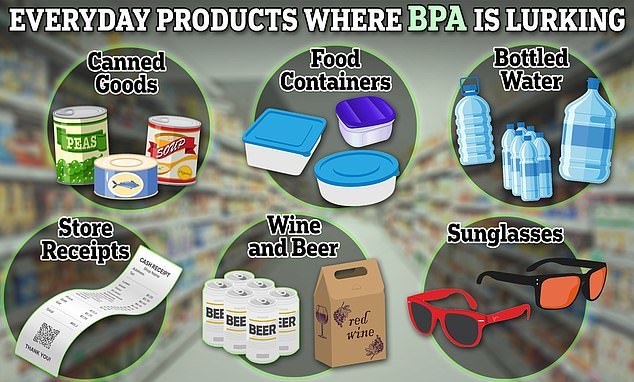Nearly 10,000 ‘hormone disrupting’ chemicals can leach into your food from ONE plastic container, study shows
- Researchers found up to 9,936 different chemicals in a single plastic product
- These include endocrine disruptors bisphenol A (BPA) and phthalates
- READ MORE: The chemicals in your garage that could increase the risk of ALS
A single plastic box of sushi or takeaway curry can contain up to 10,000 hormone-scrambling chemicals that seep into the food – with potentially harmful consequences, a new study has found.
Norwegian researchers tested various plastic food packaging from around the world and found that almost all of them contained substances that disrupt the body’s hormones or metabolism.
The chemicals include bisphenol A (BPA) and phthalates, which are known to be endocrine disruptors and have already been banned in large quantities in certain products such as baby bottles.
Exposure to these microscopic chemicals has been linked to a range of health problems, such as obesity, diabetes, reduced fertility and certain cancers.
“We found as many as 9,936 different chemicals in a single plastic product used as food packaging… we need to redesign plastic to make it safer,” said co-author Martin Wagner, professor of biology at NTNU.
The chemicals in plastics can end up in food. Previous research has also shown that plastic products leach chemicals when immersed in water

BPA is relatively common in food packaging, cans and plastic containers, despite its well-established harmful effects on the human body, such as infertility and certain cancers.
A recent report from Consumer Reports found that 99 percent of 85 foods and drinks tested contained plasticizers: chemicals used to make plastic more flexible and durable.
The researchers involved in the latest study, from the Norwegian University of Science and Technology (NTNU), tested 36 different plastic food packaging products from the US, UK, Germany, Norway and South Korea, using a two-stage process. steps to determine which chemicals were hidden in the plastic.
To start, each plastic container was cut into smaller pieces and the plastic dissolved in methanol.
This allowed the scientists to extract the chemicals in liquid form.
The chemical mixtures were then subjected to a series of laboratory tests using human cells to see whether they would activate or block human receptors involved in regulating our hormones and metabolism.
Tests include receptors for the major hormones estrogen and testosterone. In women, estrogen contributes to reproductive health and breast health, as well as cognitive health and bone health. Testosterone regulates bone mass, fat distribution, muscle mass and strength.
The scientists found that 33 of the 36 plastic products disrupted the activity of the pregnane X receptor, which is necessary for detoxifying foreign substances and also plays a role in controlling blood sugar levels and fat metabolism.
About 23 of the products contain chemicals that activate the peroxisome proliferator receptor, which is believed to be the key regulator of fat cell development.
Chemicals that blocked testosterone receptors were found in 14 products, and chemicals that mimic estrogen were found in 18 of the products.
But the researchers couldn’t fully identify what the disruptive chemicals were.
A single piece of plastic can contain thousands of different chemicals, many of which are unknown or poorly studied.
However, they did find some common chemicals, including bisphenol A (BPA) and phthalates.
But the study suggested that even BPA-free plastics contain other endocrine disruptors that have not yet been identified.
The researchers said people should remove food from plastic containers and store them in glass or stainless steel containers, especially when reheating.
Consumers should also prioritize fresh produce that comes without packaging to reduce chemical exposure, they said.
